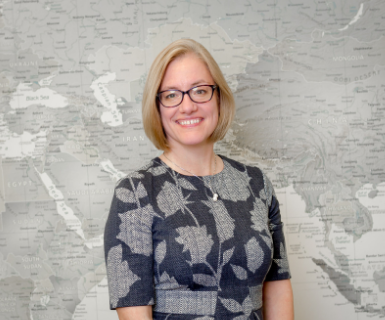By Patricia Marby Harrison, Ph.D., Director, Professional Exchanges, Global Programs, World Learning

Christopher Washington, Ph.D., outgoing Chair of the Global Ties U.S. Board of Directors, reflects on his experience on the Global Ties U.S. Board, and imagines a future that leverages technology to augment and expand leadership exchanges
It’s not every day that one lives through a paradigm shift. The last significant societal shift arguably happened with the creation of the “World Wide Web,” which changed how we shop, communicate, and do research. Even then there were stages, which we referred to as “1.0,” “2.0,” etc.
The international exchange community will remember 2020 as the year that Virtual Exchange 1.0 ended and 2.0 began. While virtual exchange had existed for several years, the necessity of Zooming forced by the pandemic drove the rest of us to virtual exchange in a hurry. By now we have figured out how to join a Webex session, how to angle our webcam, or how to navigate simultaneous interpretation. Sometimes it feels as if we have become more instructional technologists than program designers, logistics implementers, or citizen diplomats. We have been focusing on the technical skills for so long this year that perhaps at times we have lost sight of the ultimate goal – which is not simply to run webinars featuring subject matter experts, but to encourage mutual understanding.
What will Virtual Exchange 2.0 entail? I predict we will find and deploy new technologies that will enable us to convey a more authentic sense of presence and place for our participants and our communities. We can take our smartphones to site visits and give people real-time tours of the community. Apps such as Flipgrid, which enables participants to add graphics or provide written comments, or Mmhmm, which promotes “funner Zooming,” will enliven our virtual sessions. Or telepresence robots (essentially iPads on wheels, controlled remotely) may help us with the transition to hybrid (part virtual, part in-person) programs.
But it’s important not to get carried away by flashy toys: in the end, technology is only a tool by which we accomplish the essential goal of exchanges, to promote mutual understanding and build new networks for sharing information and pursuing common aims. And we want to remember not to leave behind those participants whose access to technology impedes them from participating in virtual exchanges.
The next stage of virtual exchange may require a return to the “art of programming,” to find more effective ways to facilitate conversation, increase interaction, and foster experiential learning on virtual platforms. Exchange implementers and partners can help international visitors overcome camera shyness and technology hiccups so they can participate freely, and we can encourage fewer or shorter presentations in favor of more discussion and interaction. More opportunities for participants to connect, share their expertise with each other as well as with Americans will cultivate the kind of intragroup unity and mutual learning that we have sought in our in-person programs.
It’s easy to see what has been lost in the absence of in-person programs. Experiential learning seems a challenge without the physical relocation to a new setting that travel provides. But virtual exchange has its benefits as well. Experiential learning is less about having a tangible experience, more about incorporating and applying new knowledge to one’s home context. Synthesis sessions, collaborations on a joint presentation to the group, or personal encounters that challenge assumptions can be just as effective in a virtual context. And ironically, in some ways virtual platforms provide a more direct connection to “ordinary Americans,” whether it is because of the equalizing effect of Zoom rectangles, the absence of nametags and tent cards, or the intimacy of seeing others in their living room or basement and meeting their family.
As the technology becomes more familiar, we exchange practitioners will be able to focus once again on the creativity needed to cultivate what Franklin Delano Roosevelt called “the science of human relationships,” to promote “the ability of all peoples, of all kinds, to live together and work together, in the same world, at peace.” Despite all the upheavals of 2020, perhaps because of them, the goal of exchanges remains as essential as ever.
